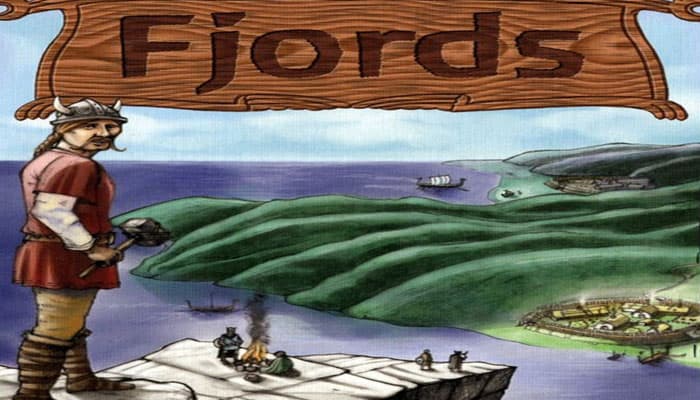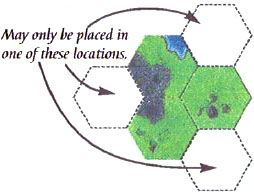

Components
- 40 landscape tiles (including 3 start tiles)
- 8 farms
- 40 fields
Setup
Each player takes the 4 farms and 20 fields in his color.
Find the three start tiles from their backs (darker than the other tiles) and place them face up in the middle of the table.

Game Play
The game is played over 3 rounds. In each round the players discover the fjord region and take areas of the region for their own.
Each of the 3 rounds is separated into two parts. First comes discovery. Here, the players together discover the fjord region and place their farms.
Then, follows land taking. Here, the players place (starting from their farms) their fields, in order to claim the largest possible part of the region. Each placed field earns the player one point. The player who has earned the most points after three rounds is the winner.
1st Part: Discovery
The players alternate turns. On a player's turn, he does the following:
Place a tile: the player must draw a landscape tile and place it, adding it to the region. If the title cannot be placed, he sets it aside face up and draws another, and so on, until he draws one he can play.
Place a farm: when a player wants, he can place one of his 4 farms on the just placed tile.
Drawing And Placing Tiles
For placing landscape tiles, use the following rules:
-
The landscape types (sea, mountain, farmland) must match on adjacent tiles.

-
Each new tile must be placed adjacent to 2 sides of tiles that were previously placed.
Note: players often forget this!

-
Players must place tiles so there is one single landmass.
A player may never place a title such that it creates a separate landmass (even for a short time). This would occur if the sea separates two landmasses. There is no limit to the number of distinct farmland and mountain areas.

If, using these rules, the player has several placing possibilities, the player may choose freely among them. If there is just one possible place for the tile, the player must place the tile there.
Note: it is also allowed for players to place tiles such that a "hole" (an empty space in the landscape) is created. This will happen rarely.
If there is no possible place for the drawn tile, the player sets it aside, face up (open choices), and draws a new tile to place. He continues drawing tiles until he finds one that can be placed.
When the drawing player does not see a place to place the tile, but his opponent does, the opponent may tell the drawing player (but need not) about the place. If he does, the drawing player must place the tile.
Open Choices
On a player's turn, he may freely choose to place one of the tiles that have been set aside (they were unplayable when drawn) if it is playable, instead of drawing a tile. A player is not required to play a playable open choice tile.
A player may choose to draw a tile even when a playable tile exists among the open choice tiles. A player may also choose to use an open choice tile after he has drawn one or more unplayable titles, setting them aside as open choices.
In no case may a player add more than 1 tile per turn to the region. Regardless of whether the player places a drawn tile or an open choice tile in the growing region, his turn ends after he places the tile and, perhaps, places one of his farms.
Players should try to choose tiles from the open choice tiles in order to become the starting player in the land taking part of the round..
Placing Farms
Each player has 4 farms. After placing a tile, the player must always decide whether to place one of his farms on the just-placed tile or not A player may never place a farm on a previously placed title.
The player may only place a farm on farmland segment. There is 1 title that has only mountains. This title and the 3 start rites are the only tiles that players can never place farms on.
A player need not place all 4 of his farms, but this is rarely wise.
2nd Part: Land Taking
After the last face down title has been drawn and placed in the region or set aside as an open choice title, the 1st part ends. All open choice titles are out of the game, even those that could now be played. Leave them aside until the beginning of the next round.
Now the players begin land taking, that is, placing their fields. As before, the players take turns placing their fields. Who places the first field? There are two possibilities:
Player A played the last drawn tile on the fjord region. In this case, player B plays the first field.
 Player A drew the last face down tile, but could not place it in the region, so he sets it aside among the open choice tiles. In this case, player A plays the first field.
Player A drew the last face down tile, but could not place it in the region, so he sets it aside among the open choice tiles. In this case, player A plays the first field.
Each player must play his first field next to one of his farms. Each places later fields either next to one of his farms or one of his fields.
Placing Fields

A player may only place a field on an empty farmland segment, not on mountains or seas.
A player may only place a field that is directly adjacent to at least one farmland segment with one of his fields or farms. Adjacent tiles with farmland segments separated from one of his fields or farms by mountains or seas do not count!
Players try to place fields so that they create an area of farmland segments that their opponent cannot reach. When a player has done this, he should concentrate field placements on farmland segments that are still contested.
As soon as fields have been placed on all contested farmland segments, players place their fields on the farmland segments they have secured (where their opponent cannot place fields).
Then, the land taking ends. It is possible that some farmland segments have no fields. This can happen if the fields are separated from farms by mountains or seas.
Scoring and New Round
The winner of the round is the player who placed more fields than the other (farms are not counted). Each player records the number of fields he placed as points with paper and pencil.
The next round begins as the first with the 3 start tiles and all other tiles shuffled in face down stacks. The loser of the previous round starts.
End of the Game
The players play 3 rounds with new fjord regions each time.
After the third round, the players sum their points for the 3 rounds. The player with the most points is the winner.
If the players tie, the player who won 2 rounds is the winner.
In the unlikely case that no player wins 2 rounds, the players rejoice in their shared victory!
Continue Reading
